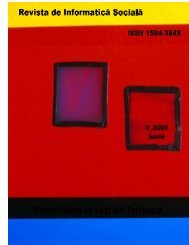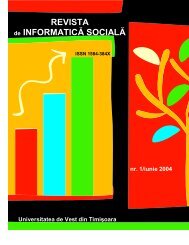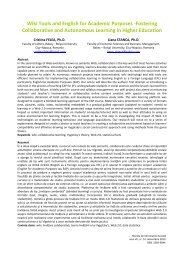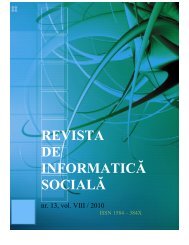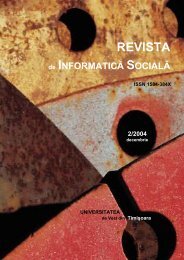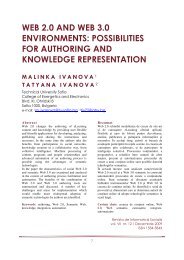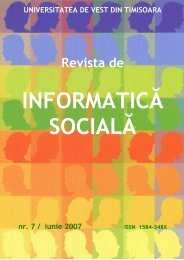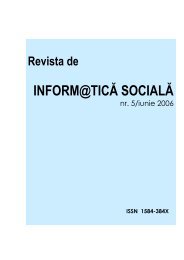Stage I: Online/Blen<strong>de</strong>d/e-Learning InnovationsThe first stage is one in which traditional institutions enable their faculty to put courses online andprogressively create various forms <strong>of</strong> online, blen<strong>de</strong>d and e-learning <strong>of</strong>ferings un<strong>de</strong>r theinstitutional brand. These <strong>of</strong>ferings are <strong>of</strong>ten more expensive to <strong>de</strong>velop and launch than thetraditional institutional <strong>of</strong>ferings. They do not achieve any breakthrough economies, may usetraditional or adjunct faculty and replicate many existing practices. They do not use technology totruly transform faculty roles and patterns <strong>of</strong> interactivity, or to link stu<strong>de</strong>nts to discussions in noncoursecommunities that could enhance the ability <strong>of</strong> stu<strong>de</strong>nts to apply what they learn and/orbecome more employable. In the long run, this “digitize-the-traditional-and-incrementally-improveit”approach to online learning is a transitional state. This mo<strong>de</strong>l will not add to nationalproductivity so it will not be sustainable in the face <strong>of</strong> global competition.Online/blen<strong>de</strong>d/e-learning innovations can work to reduce the overall cost to stu<strong>de</strong>nts and theinstitution, even if the tuition charged to stu<strong>de</strong>nts is the same or greater than the tuition for face-t<strong>of</strong>aceinstruction. Online stu<strong>de</strong>nts not only save on transportation costs, they reduce the opportunitycosts <strong>of</strong> travel time, lost income and such. These can be significant savings. Blen<strong>de</strong>d learning cansave institutions the cost <strong>of</strong> new facilities by reducing classroom <strong>de</strong>mand and allowing institutionsto reduce the impact <strong>of</strong> commuter stu<strong>de</strong>nt traffic and use <strong>of</strong> on-campus facilities and services.Campuses in hyper-growth metropolitan areas like the University <strong>of</strong> Central Florida usecombinations <strong>of</strong> online, blen<strong>de</strong>d, and e-learning to “sculpt” enrollments at their multiple physicalcampuses and in virtual learning spaces.Moreover, the market lea<strong>de</strong>rs in online learning have shown that technology can be used tounbundle and transform the existing classroom-centric mo<strong>de</strong>l for individual courses. The course reinventionefforts <strong>of</strong> Twigg [3] at the National Center for Aca<strong>de</strong>mic Transformation (NCAT) haveimproved performance and stu<strong>de</strong>nt success and reduced costs in virtually every physical or virtualcourse they have re-<strong>de</strong>signed. Some institutions are scaling these processes to <strong>de</strong>partmental,institutional or even system level. But the greatest challenge to scaling these approaches across theinstitutions has proven to be getting institutional lea<strong>de</strong>rship seriously interested in reducing costssystemically, which some associate with diminishing quality. Twigg has succee<strong>de</strong>d in achievingenthusiastic and effective faculty participation in course re-<strong>de</strong>sign as long as any cost savingsremain with the aca<strong>de</strong>mic units.In times <strong>of</strong> constrained resources, institutional lea<strong>de</strong>rs need to focus on value, as well as quality,and to systemically reduce costs and “harvest” the savings. A genuine commitment to performancemeasurement and improvement requires a <strong>de</strong>dication to cost reduction in ways that do not diminishoutcomes.Summary <strong>of</strong> Stage I: Online, Blen<strong>de</strong>d and eLearningCharacteristics: Develop and gain acceptance for online, blen<strong>de</strong>d and e-learningTransformative Impact: Typically digitized existing aca<strong>de</strong>mic roles and practices. In manycases stu<strong>de</strong>nts pay an online “premium.”Impacts on Institutional/Stu<strong>de</strong>nt Costs: Universities like UCF use a combination <strong>of</strong> online,blen<strong>de</strong>d and e-learning, <strong>of</strong>fered virtually and/or on their main campus and regional campuses toincrease stu<strong>de</strong>nt options, reduce opportunity costs for stu<strong>de</strong>nts and reduce need for newfacilities.Exemplary Institutions/Participants: University <strong>of</strong> Central Florida – exemplary leveraging <strong>of</strong> online/blen<strong>de</strong>d/e-learningSloan Consortium – Gain acceptance for online and blen<strong>de</strong>d learningNational Center for Aca<strong>de</strong>mic Transformation – Course Re<strong>de</strong>sign results in improvedresults and reduced costs
Recently, Twigg has received support to work with community colleges in re<strong>de</strong>signing theintroductory-level courses that constitute the gateway through which most stu<strong>de</strong>nts must pass. Thiseffort is receiving serious financial support from foundations. Significant re<strong>de</strong>sign <strong>of</strong> these coursescould be part <strong>of</strong> a broa<strong>de</strong>r campaign to improve success, reduce costs and achieve financialsustainability. Efforts at course re-invention can be a good start, but they are not sufficient bythemselves to meet the challenges <strong>of</strong> establishing financial sustainability, post-recession.Sustainable online learning requires pervasive adoption <strong>of</strong> unbundling, re-invention and a valuefocus to the entire online learning enterprise.Many institutions remain stuck in the digitize-the-traditional-but-don’t-re-invent stage <strong>of</strong><strong>de</strong>velopment. In the 2009 “Managing Online Programs Survey” sponsored by The CampusComputing Project and WCET [7] most institutions were still searching for satisfactory, sustainablemo<strong>de</strong>ls for organizing and <strong>de</strong>livering online learning. They will continue to search fruitlessly unlessthey apply the following principle: The key to evolving new, sustainable mo<strong>de</strong>ls for online learningis to utilize technology to:unbundle and re-invent teaching, learning, assessment and certification;focus on perceived value, not just quality (perceived value consists <strong>of</strong> the learner’sperception <strong>of</strong> achieving <strong>de</strong>sired outcomes in an experience attuned to the learner’s needs andcircumstances – especially important for adult, working learners - and at an affordableprice);focus on value-ad<strong>de</strong>d approaches: help learners to become more valuable to employers, (e.g.use learning systems to encourage collaborative work-focused application <strong>of</strong> coursecontent);change the use and roles <strong>of</strong> faculty, mentors and peer-to-peer learning; andtransform business mo<strong>de</strong>ls by: 1) continuously seeking new income streams that canmitigate the need to continuously increase tuition charges to fill revenue gaps; 2) reducinginci<strong>de</strong>ntal (unrelated to learning) operational overheads such as new administrationbuildings, parking lots and dorms; 3) seeking lower price points and enabling more rapidcompletion <strong>of</strong> learning objectives; and 4) reducing the total cost <strong>of</strong> achieving learning goals.We remain hopeful that online, blen<strong>de</strong>d and e-learning innovators will seize the opportunity tomove on to transformation when they un<strong>de</strong>rstand the potentials provi<strong>de</strong>d by Stages II-V, thechallenges provi<strong>de</strong>d by the open learning movement and the imperative <strong>of</strong> the Great Recession. Thefollowing stages illustrate how this evolution is being followed by market lea<strong>de</strong>rs.Stage II: First Generation Unbundled OfferingsThis stage <strong>de</strong>veloped at the same time as Stage I, but in different organizational cultures: for-pr<strong>of</strong>itinstitutions (and a small group <strong>of</strong> not-for-pr<strong>of</strong>it universities that <strong>de</strong>ploy these techniques). Inaddition to unbundled <strong>of</strong>fering, it featured re-invented business practices, production mo<strong>de</strong>ls andbusiness mo<strong>de</strong>ls, plus the capacity to charge a premium price.The for-pr<strong>of</strong>its such as the University <strong>of</strong> Phoenix, Capella University, Kaplan and others haveutilized technology-supported learning to: re-invent their production function (using team-<strong>de</strong>veloped resources in all instances <strong>of</strong>creating courses); engage mentors (who are not content experts) rather than traditional, tenure-track faculty;and <strong>de</strong>ploy world-class (high-quality, high-value) online support services.These provi<strong>de</strong>rs also vet their <strong>of</strong>ferings with employers more extensively, continuously an<strong>de</strong>ffectively than traditional universities. This is neither black magic nor rocket science. The not-forpr<strong>of</strong>itUK Open University pioneered and published many <strong>of</strong> these practices over 30 years ago,although some campus-based UK universities are only now beginning to adopt those practices. The
- Page 1: Revista de Informatica Sociala 14 /
- Page 7: ● ● ●CONTENTS● ● ●[9-20
- Page 10 and 11: THE TRANSITION FROM OLD TO NEW MEDI
- Page 12 and 13: 30252023.420.325.11510500.85.5Never
- Page 14 and 15: Overall, we can therefore sum up on
- Page 16 and 17: n.a.I often use itI seldom use it6.
- Page 18 and 19: - Traditional web use: searching th
- Page 20 and 21: 19. Kvavik R.B., Caruso J.B. and Mo
- Page 22: IntroductionIn 1995, Bernie Dodge o
- Page 25 and 26: The Web-Inquiry Project [WIP] is a
- Page 27 and 28: and even orally. The teacher will a
- Page 29 and 30: environment in which the teacher gu
- Page 31 and 32: Transformation Through Online Learn
- Page 33 and 34: INTRODUCTIONLeading practitioners a
- Page 35 and 36: learning. We also describe how the
- Page 37: Some of these transformations are b
- Page 41 and 42: Stage III: Unbundled Learning, Mark
- Page 43 and 44: perhaps using Second Life-like virt
- Page 45 and 46: performance. Indeed, Stage V will l
- Page 47 and 48: Free-Range Open LearningOver time,
- Page 49 and 50: New communities, tools and services
- Page 51 and 52: Embed enterprise-wide predictive an
- Page 53 and 54: In collaboration with Strategic Ini
- Page 55 and 56: Wiki Tools and English for Academic
- Page 57 and 58: eality. Besides being an additional
- Page 59 and 60: StudentPage 1StudentPage nTeacher
- Page 61 and 62: 100%90%80%70%60%50%40%30%20%10%0%Ac
- Page 63 and 64: 200Correlation View/Page Edits150Vi
- Page 65 and 66: 14. http://eacea.ec.europa.eu/llp/s
- Page 67 and 68: Simularea şi comunicarea electroni
- Page 69 and 70: RespondenţiRăspunsuriLa nivelul
- Page 71 and 72: RespondenţiRăspunsuriLa nivelul
- Page 73 and 74: Respondenţii au fost rugaţi să i
- Page 75 and 76: Itemul 9 doreşte să identifice ti
- Page 77 and 78: Identificara opţiunii, chiar şi p
- Page 79 and 80: EşantioaneRăspunsuri/Ranguriagita
- Page 81 and 82: modalităţile practice prin care u
- Page 83 and 84: 1. INTRODUCEREÎn prezent, complexi
- Page 85 and 86: Figura 1. Analiza grafică a evolu
- Page 87 and 88: Faţă de această situaţie se deg
- Page 89 and 90:
variabilele acesti noi culturi cybe
- Page 91 and 92:
INTRODUCEREÎncă din anul 2000 am
- Page 93 and 94:
după tipul lecţiei: prezentare de
- Page 95 and 96:
Funcţiile oferite de AEL asigură
- Page 97 and 98:
• elevi/studenţi, beneficiari di
- Page 99 and 100:
Se poate folosi cadrul formal de co
- Page 102 and 103:
Evaluarea formativă este comentari
- Page 104 and 105:
Rezultatele elevilor, pe itemi:Diag
- Page 106 and 107:
Nr. Denumirea activităţii AEL MOO
- Page 108 and 109:
SEMNAL EDITORIALLaura MALITA, Vanna
- Page 110:
IN MEMORIAMConstantin TraianCHEVERE



